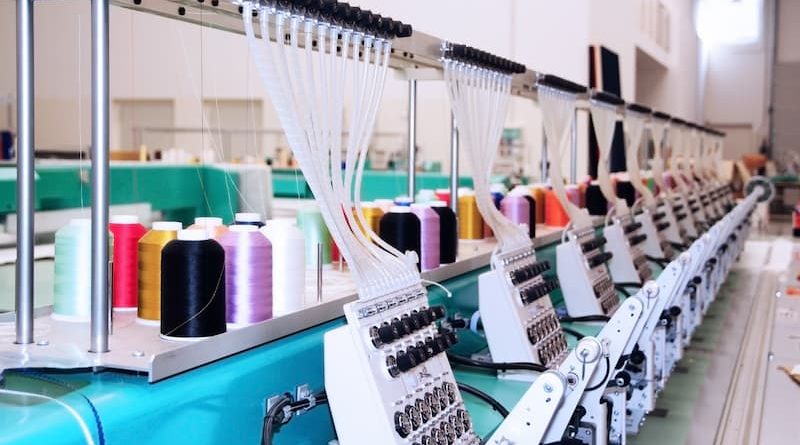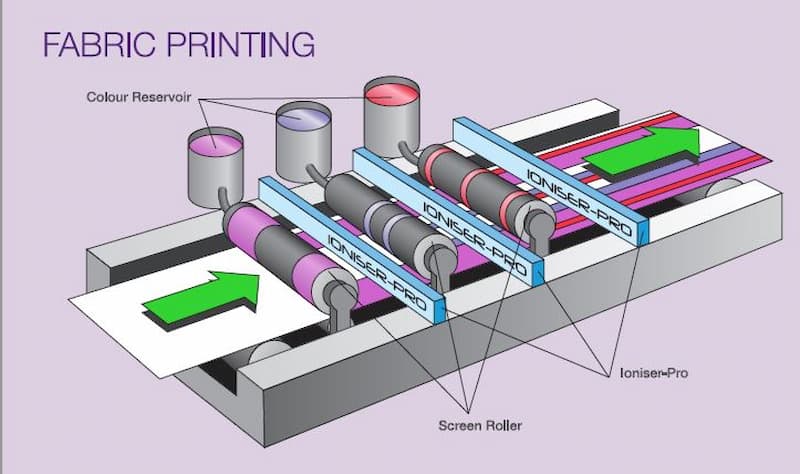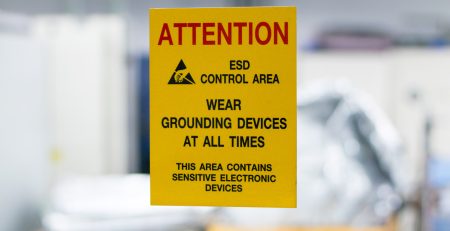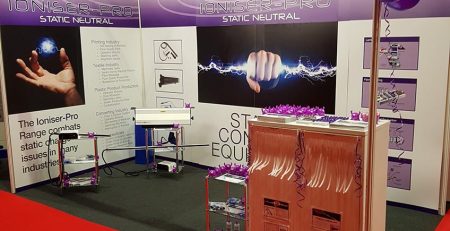Static Solutions for Textile Printing
Static electricity will always be generated during textile manufacturing due to the nature of the industry. In addition, the industry’s growing use of artificial fibres has increased the problem of static electricity. This build-up of static is unfortunately unavoidable, but it can be controlled with the application of effective anti-static products.
 What is Static Electricity?
What is Static Electricity?
The basics of static electricity are that everything is electrically charged, either positively or negatively. Static electricity is a non-neutral electric charge from an imbalance between negatively and positively charged objects.
We notice static electricity when two objects touch, and an exchange of electrons happens. However, this exchange builds a charge once separated (if the two objects are not grounded). This is called the triboelectric effect. This imbalanced charge is corrected once the object comes into contact with something charged the opposite way; it violently sheds its excess energy behind the imbalance and causes the shock we feel.
Static in Textile Printing
Like any part of textile production, high-quality printing is dependent on a consistently controlled environment. Any erratic changes like humidity and static build-up will damage your print quality and leave you with a worse product.
Humidity plays an essential role in textile printing. Therefore, it’s important to find the optimal balance for the textiles you are working with. Too high a humidity level will negatively affect your machines and their materials. For example, a humid environment will lower the quality of your printing and reduce the elasticity of some fabrics.
On the other hand, an environment with no humidity will make the textile release its moisture into the atmosphere and dry it out. This will weaken the material and increase the amount of static it generates.
 Problems with Static in Textiles
Problems with Static in Textiles
During production, many processes generate a static charge. From carding, warping, beaming and printing, it’s vital to instal effective static control at these locations to reliably control that generated static and prevent it from disrupting your production.
For example, as fibres are carded, static will cause the fibres to cling to any nearby surfaces or machinery, causing havoc for your company with erratic products and machine breakdowns. Depending on your material, each layer of yarn coming from a creel may need to be neutralised to prevent any potential thread breaks.
Textile folding machines generate a lot of static electricity as they move the fabrics around. These items will seemingly stick to conveyor systems as they travel, causing more interruptions or breakdowns for your machinery. Most industrial textile printing is computerised, so making sure you employ adequate anti-static products in your workflow is vital to protect your invaluable automated machines as well as your products.
Dangers of Static in Textiles
Beyond the potential damage to the printed fabrics, uncontrolled ESD can also cause problems in other production areas. For example, the shocks will damage electrical equipment nearby.
ESD can even cause combustible materials to ignite, putting your whole business at risk. Therefore, when working with dried out fabric fibres in a charged environment filled with dust, it’s vital for everyone’s safety that effective ESD control is put in place to prevent any discharges causing sparks amidst flammable materials.
While ESD shocks directly to a person may seem pretty small when you get a jolt touching a door handle, a static discharge can be several thousand volts and reach up to 5 inches in the textiles industry. An uncontrolled ESD can cause a person severe harm, with 10,000 volts being lethal. By employing various static control methods throughout your workflow and anti-static textiles, you can ensure the productivity and safety of your whole team.
How Different Materials React to Static
Not all textile fabrics will react the same with static. For example, polyester and nylon are both lightweight, and their fibres contain low moisture; these fibres are more easily statically charged than others.
The wool and cotton industries suffer from static during the carding and spinning phases. Uncontrolled static will weaken the fibres and create irregularities amidst the yarns.
 Anti-Static Bars from Ioniser-Pro
Anti-Static Bars from Ioniser-Pro
At Ioniser-Pro, we can supply you with the best anti-static products. In the context of textiles printing, we recommend our anti-static bars.
Units such as our Ioniser-Pro 1200 Static Eliminator are a prevalent choice for assisting businesses in static control. This compact, easily mountable package can be installed between your printing rollers to prevent any static contamination that could damage your product. Unlike other anti-static bars, we supply this one that can be mounted well away from any moving components whilst still effectively removing unwanted static from the area.
Effective ESD Solutions
If left unchecked, electrostatic discharge can harm your employees, disrupt production and risk your business. At Ioniser-Pro, we understand that every company is different, and there is no one answer to every business’s unique static control needs. We offer a wide range of anti-static products to cover every situation you may need.
If you’re interested in our ESD solutions, why not browse our selection of anti-static bars or any other static solutions on our website.

 What is Static Electricity?
What is Static Electricity? Problems with Static in Textiles
Problems with Static in Textiles Anti-Static Bars from Ioniser-Pro
Anti-Static Bars from Ioniser-Pro









